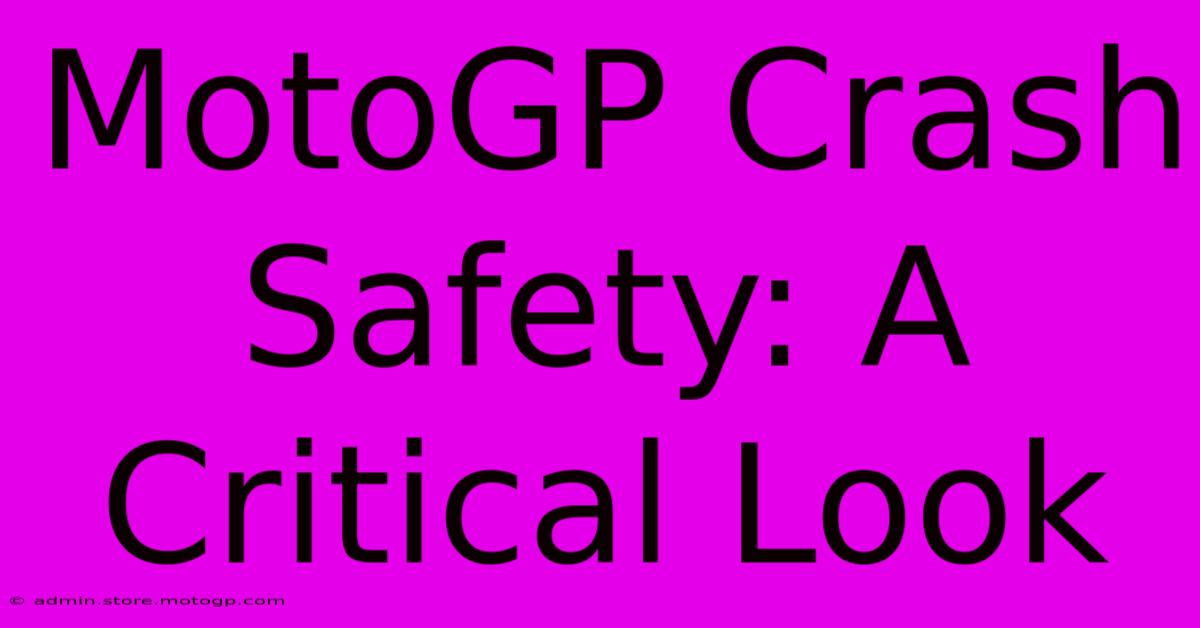MotoGP Crash Safety: A Critical Look

Table of Contents
MotoGP Crash Safety: A Critical Look
Motorcycle racing, particularly at the MotoGP level, is a breathtaking spectacle of skill and speed. However, the inherent risks are undeniable. High speeds, aggressive maneuvers, and unforgiving tracks make crashes an unfortunate, yet inevitable, part of the sport. This article will delve into the critical aspects of MotoGP crash safety, examining both the advancements made and the ongoing challenges.
The Evolution of Safety Technology in MotoGP
The sport has witnessed a significant evolution in safety technology over the years, aiming to mitigate the severity of crashes and protect riders. Key advancements include:
1. Advanced Protective Gear:
- The Racing Suit: Modern racing suits are far beyond simple leather jackets. They're constructed from highly abrasion-resistant materials like kangaroo leather, incorporating strategically placed armor and impact-absorbing padding. Innovations continue with the development of new materials offering even greater protection.
- Helmets: Helmets are crucial, undergoing rigorous testing to withstand immense forces. Advanced designs incorporate improved shell construction, enhanced visor mechanisms, and sophisticated impact-absorption technologies.
- Airbag Systems: Many riders now use airbag systems integrated into their suits. These rapidly inflate upon impact, providing crucial cushioning and reducing the risk of serious injuries.
2. Track Improvements and Safety Features:
- Run-off Areas: Significant investment has gone into expanding and improving run-off areas at circuits. These areas, often filled with gravel or other impact-absorbing materials, are designed to slow down bikes after a crash.
- Air Fences and Tec-Pro Barriers: Modern tracks increasingly utilize air fences and Tec-Pro barriers—flexible barriers designed to absorb the impact of a bike and redirect it away from the track, minimizing the risk of secondary crashes.
- Improved Track Design: Track designers are incorporating safer cornering approaches and reducing blind spots to lessen the potential for high-speed collisions.
3. Medical Advancements:
- On-Track Medical Teams: Highly skilled medical professionals are always on hand at MotoGP events, ready to provide immediate medical care to injured riders. The use of helicopters for rapid transport to hospitals is commonplace.
- Improved Emergency Response Procedures: Efficient protocols are in place to ensure swift response times and effective evacuation of injured riders from the track.
- Advanced Medical Technologies: The continuous advancement of medical technologies and techniques plays a vital role in treating injuries sustained during crashes, leading to improved outcomes and rehabilitation.
Ongoing Challenges and Future Directions
Despite the significant progress, challenges remain in the pursuit of enhanced safety in MotoGP:
- High Speeds: The sheer speed of MotoGP bikes remains a significant factor. Even with advanced safety measures, the forces involved in a high-speed crash can be devastating.
- Rider Behavior: Rider errors, aggressive overtaking maneuvers, and racing incidents are still leading causes of crashes. Improved rider training and stricter race regulations may help.
- Unpredictable Track Conditions: Varying weather conditions and track surface changes can also contribute to crashes. Ongoing improvements in track design and maintenance are crucial.
The future of MotoGP safety likely involves:
- Further Development of Protective Gear: Research into lighter, stronger, and more effective materials for racing suits and helmets continues.
- Advanced Crash Mitigation Systems: Investigating and implementing technologies that can proactively prevent or lessen the impact of crashes, such as advanced rider assistance systems.
- Data-Driven Analysis: Leveraging extensive data analysis to better understand accident causes and inform improvements in track design, safety regulations, and rider training.
Conclusion:
MotoGP crash safety has come a long way. However, it is an ongoing process requiring continual investment in research, technology, and infrastructure. While the pursuit of zero crashes remains an ambitious goal, the dedication to improving safety measures demonstrates the sport's commitment to the well-being of its riders. The combination of technological advancements, improved track safety, and efficient medical response systems continually strives to reduce the risks associated with this thrilling yet dangerous sport.

Thank you for visiting our website wich cover about MotoGP Crash Safety: A Critical Look. We hope the information provided has been useful to you. Feel free to contact us if you have any questions or need further assistance. See you next time and dont miss to bookmark.
Featured Posts
-
Moto Gp Sprint Races Explained
Feb 19, 2025
-
Moto 2 Specs The Ultimate Performance Package
Feb 19, 2025
-
Moto Gp Top Speed A Visual Feast
Feb 19, 2025
-
A Legacy Of Speed Whos The Best Motorcyclist
Feb 19, 2025
-
Moto Gp Sprint Results Witness The Intensity
Feb 19, 2025
